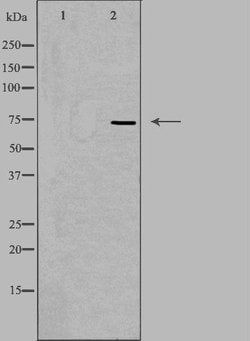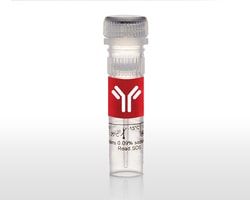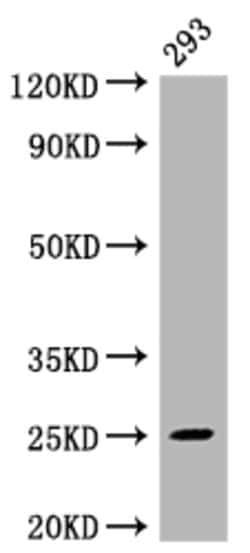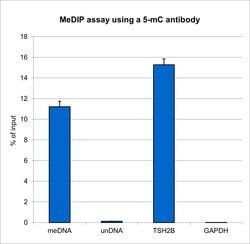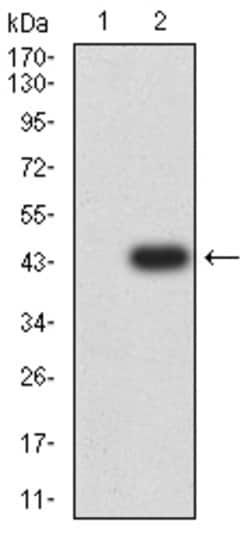PIMA538429
MAOB Recombinant Rabbit Monoclonal Antibody (9B6), Invitrogen™
Manufacturer: Thermo Scientific
Select a Size
| Pack Size | SKU | Availability | Price |
|---|---|---|---|
| Each of 1 | PIMA538429-Each-of-1 | In Stock | ₹ 53,088.50 |
PIMA538429 - Each of 1
In Stock
Quantity
1
Base Price: ₹ 53,088.50
GST (18%): ₹ 9,555.93
Total Price: ₹ 62,644.43
Antigen
MAOB
Classification
Recombinant Monoclonal
Concentration
2 mg/mL
Formulation
PBS with 150mM NaCl, 50% glycerol and 0.02% sodium azide; pH 7.4
Gene Accession No.
P27338
Gene Symbols
MAOB
Immunogen
A synthesized peptide derived from human Monoamine Oxidase B
Quantity
100 μL
Primary or Secondary
Primary
Target Species
Human
Product Type
Antibody
Isotype
IgG
Applications
Immunohistochemistry (Paraffin), Western Blot
Clone
9B6
Conjugate
Unconjugated
Gene
MAOB
Gene Alias
6330414K01Rik; adrenalin oxidase; amine oxidase [flavin-containing] B; HGNC:6834; MAO b; MAO, brain; MAO, platelet; Maob; MAO-B; MGC26382; monoamine oxidase B; monoamine oxidase type B; monoamine oxidase-B; RP1-201D17__B.1; tyramine oxidase
Host Species
Rabbit
Purification Method
Affinity chromatography
Regulatory Status
RUO
Gene ID (Entrez)
4129
Content And Storage
-20°C or -80°C if preferred
Form
Liquid
Description
- This antibody has been tested in direct-ELISA MAOB (Monoamine Oxidase B), also called MAO, BRAIN, AMINE OXIDASE (FLAVIN-CONTAINING) B, is a protein that in humans is encoded by the MAOB gene
- MAOB is a member of the flavin monoamine oxidase family
- And it is mapped on Xp11.3
- MAOB catalyzes the oxidative deamination of biogenic and xenobiotic amines and plays an important role in the metabolism of neuroactive and vasoactive amines in the central nervous system and peripheral tissues
- This protein preferentially degrades benzylamine and phenylethylamine
- Like MAOA, it also degrades dopamine
- MAO-B is involved in the breakdown of dopamine, a neurotransmitter implicated in reinforcing and motivating behaviors as well as movement
- MAO-B inhibition is, therefore, associated with enhanced activity of dopamine, as well as with decreased production of hydrogen peroxide, a source of reactive oxygen species.
Compare Similar Items
Show Difference
Antigen: MAOB
Classification: Recombinant Monoclonal
Concentration: 2 mg/mL
Formulation: PBS with 150mM NaCl, 50% glycerol and 0.02% sodium azide; pH 7.4
Gene Accession No.: P27338
Gene Symbols: MAOB
Immunogen: A synthesized peptide derived from human Monoamine Oxidase B
Quantity: 100 μL
Primary or Secondary: Primary
Target Species: Human
Product Type: Antibody
Isotype: IgG
Applications: Immunohistochemistry (Paraffin), Western Blot
Clone: 9B6
Conjugate: Unconjugated
Gene: MAOB
Gene Alias: 6330414K01Rik; adrenalin oxidase; amine oxidase [flavin-containing] B; HGNC:6834; MAO b; MAO, brain; MAO, platelet; Maob; MAO-B; MGC26382; monoamine oxidase B; monoamine oxidase type B; monoamine oxidase-B; RP1-201D17__B.1; tyramine oxidase
Host Species: Rabbit
Purification Method: Affinity chromatography
Regulatory Status: RUO
Gene ID (Entrez): 4129
Content And Storage: -20°C or -80°C if preferred
Form: Liquid
Antigen:
MAOB
Classification:
Recombinant Monoclonal
Concentration:
2 mg/mL
Formulation:
PBS with 150mM NaCl, 50% glycerol and 0.02% sodium azide; pH 7.4
Gene Accession No.:
P27338
Gene Symbols:
MAOB
Immunogen:
A synthesized peptide derived from human Monoamine Oxidase B
Quantity:
100 μL
Primary or Secondary:
Primary
Target Species:
Human
Product Type:
Antibody
Isotype:
IgG
Applications:
Immunohistochemistry (Paraffin), Western Blot
Clone:
9B6
Conjugate:
Unconjugated
Gene:
MAOB
Gene Alias:
6330414K01Rik; adrenalin oxidase; amine oxidase [flavin-containing] B; HGNC:6834; MAO b; MAO, brain; MAO, platelet; Maob; MAO-B; MGC26382; monoamine oxidase B; monoamine oxidase type B; monoamine oxidase-B; RP1-201D17__B.1; tyramine oxidase
Host Species:
Rabbit
Purification Method:
Affinity chromatography
Regulatory Status:
RUO
Gene ID (Entrez):
4129
Content And Storage:
-20°C or -80°C if preferred
Form:
Liquid
Antigen: H3K9me3
Classification: Monoclonal
Concentration: __
Formulation: tissue culture supernatant with 0.05% sodium azide
Gene Accession No.: P68431, Q71DI3
Gene Symbols: H3C1, H3C10, H3C12, H3C14, H3C15, H3C2, H3C7
Immunogen: H3K9me3 synthetic peptide
Quantity: 100 μL
Primary or Secondary: Primary
Target Species: Human
Product Type: Antibody
Isotype: IgG1
Applications: ChIP Assay, Dot Blot, Western Blot
Clone: DTA1001
Conjugate: Unconjugated
Gene: H3C1
Gene Alias: B0035.7; CELE_T10C6.12; F07B7.10; F07B7.3; F08G2.2; F17E9.13; F35H10.1; F45F2.4; F54E12.5; F55G1.10; H02I12.7; H3; H3 histone; H3 histone family, member A; H3 histone family, member I; H3 histone family, member K; H3 histone family, member L; H3 histone family, member M; H3 histone, family 2; H3 histone, family 3A; H3 histone, family 3B; H3 histone, family 3B (H3.3B); H3 histone, family 3B.1; H3 histone, family 3C; H3 K9; H3.1-221; H3.1-291; H3.1-I; H3.2; H3.2-221; H3.2-614; H3.2-615; H3.2-616; H3.3A; H3.3B; H3.5; H3/A; H3/b; H3/d; H3/f; H3/i; H3/j; H3/k; H3/l; H3/M; H3/n; H3/o; H3-143; H3-291; H3-3A; H3-3B; h3-5; H3-53; H3-614; H3a; H3b; H3-B; H3c1; H3c10; H3C11; H3C12; H3C2; H3C3; H3C4; H3C6; H3C7; H3C8; H3f; H3-F; H3F1K; H3F2; H3F3; h3f3a; H3F3B; h3f3b.1; h3f3c; h3f3d; H3FA; H3FB; H3FC HIST1H3C; H3FD; H3FF; H3FH; H3FI; H3FJ; H3FK; H3FL; H3FM; H3FN; H3g; H3h; H3i; H3K9; H3Lys9me3; his-12; his-16; his-19; his-21; his-3; his-30; his-33; his-43; his-47; his-51; his-53; his-57; his-61; his-65; his-68; his-7; Hist1; Hist1h3a; HIST1H3B; Hist1h3c; Hist1h3d; HIST1H3E; Hist1h3f; HIST1H3G; Hist1h3h; HIST1H3I; HIST1H3J; HIST2H3A; Hist2h3b; HIST2H3C; Hist2h3c1; Hist2h3c2; Hist2h3c2-ps; Hist2h3ca1; Hist2h3ca2; HIST2H3D; histone 1, H3a; histone 1, H3b; histone 1, H3f; histone 1, H3h; histone 2, H3a; histone 2, H3c; histone 2, H3c2; histone 2, H3ca2; Histone 3; histone cluster 1, H3a; histone cluster 1, H3b; histone cluster 1, H3f; histone cluster 1, H3h; histone cluster 2, H3a; histone cluster 2, H3c; histone cluster 2, H3c2; histone cluster 2, H3c2, pseudogene; histone gene complex 1; Histone H2A; histone H3; histone H3.1; Histone H3.2; histone H3.3; Histone H3.3C; histone H3.5; Histone H3/a; Histone H3/b; Histone H3/c; Histone H3/d; Histone H3/f; Histone H3/h; Histone H3/i; Histone H3/j; Histone H3/k; histone H3/l; Histone H3/m; histone H3/o; Histone H3K9me3; histone variant H3.5; hypothetical protein LOC550262; K06C4.11; K06C4.3; M32461; methyl Histone 3; methyl Histone H3; PP781; T10C6.12; T23D8.6; Trimethyl H3; Tri-methyl H3; Trimethyl Histone H3; Tri-methyl Histone H3; Tri-Methyl-H3 K9; Tri-Methyl-H3 Lys9; Tri-Methyl-Histone H3 K9; Tri-Methyl-Histone H3 Lys9; wu:fa25h06; wu:fa96g06; wu:fb07a08; wu:fb36f01; zgc:110292; zgc:174300; zgc:56193; zgc:56418; zgc:64222; zgc:86731; ZK131.10; ZK131.6
Host Species: Mouse
Purification Method: selective precipitation
Regulatory Status: RUO
Gene ID (Entrez): 126961, 333932, 8350, 8356, 8357, 8358, 8968
Content And Storage: -20°C or -80°C if preferred
Form: Liquid
Antigen:
H3K9me3
Classification:
Monoclonal
Concentration:
__
Formulation:
tissue culture supernatant with 0.05% sodium azide
Gene Accession No.:
P68431, Q71DI3
Gene Symbols:
H3C1, H3C10, H3C12, H3C14, H3C15, H3C2, H3C7
Immunogen:
H3K9me3 synthetic peptide
Quantity:
100 μL
Primary or Secondary:
Primary
Target Species:
Human
Product Type:
Antibody
Isotype:
IgG1
Applications:
ChIP Assay, Dot Blot, Western Blot
Clone:
DTA1001
Conjugate:
Unconjugated
Gene:
H3C1
Gene Alias:
B0035.7; CELE_T10C6.12; F07B7.10; F07B7.3; F08G2.2; F17E9.13; F35H10.1; F45F2.4; F54E12.5; F55G1.10; H02I12.7; H3; H3 histone; H3 histone family, member A; H3 histone family, member I; H3 histone family, member K; H3 histone family, member L; H3 histone family, member M; H3 histone, family 2; H3 histone, family 3A; H3 histone, family 3B; H3 histone, family 3B (H3.3B); H3 histone, family 3B.1; H3 histone, family 3C; H3 K9; H3.1-221; H3.1-291; H3.1-I; H3.2; H3.2-221; H3.2-614; H3.2-615; H3.2-616; H3.3A; H3.3B; H3.5; H3/A; H3/b; H3/d; H3/f; H3/i; H3/j; H3/k; H3/l; H3/M; H3/n; H3/o; H3-143; H3-291; H3-3A; H3-3B; h3-5; H3-53; H3-614; H3a; H3b; H3-B; H3c1; H3c10; H3C11; H3C12; H3C2; H3C3; H3C4; H3C6; H3C7; H3C8; H3f; H3-F; H3F1K; H3F2; H3F3; h3f3a; H3F3B; h3f3b.1; h3f3c; h3f3d; H3FA; H3FB; H3FC HIST1H3C; H3FD; H3FF; H3FH; H3FI; H3FJ; H3FK; H3FL; H3FM; H3FN; H3g; H3h; H3i; H3K9; H3Lys9me3; his-12; his-16; his-19; his-21; his-3; his-30; his-33; his-43; his-47; his-51; his-53; his-57; his-61; his-65; his-68; his-7; Hist1; Hist1h3a; HIST1H3B; Hist1h3c; Hist1h3d; HIST1H3E; Hist1h3f; HIST1H3G; Hist1h3h; HIST1H3I; HIST1H3J; HIST2H3A; Hist2h3b; HIST2H3C; Hist2h3c1; Hist2h3c2; Hist2h3c2-ps; Hist2h3ca1; Hist2h3ca2; HIST2H3D; histone 1, H3a; histone 1, H3b; histone 1, H3f; histone 1, H3h; histone 2, H3a; histone 2, H3c; histone 2, H3c2; histone 2, H3ca2; Histone 3; histone cluster 1, H3a; histone cluster 1, H3b; histone cluster 1, H3f; histone cluster 1, H3h; histone cluster 2, H3a; histone cluster 2, H3c; histone cluster 2, H3c2; histone cluster 2, H3c2, pseudogene; histone gene complex 1; Histone H2A; histone H3; histone H3.1; Histone H3.2; histone H3.3; Histone H3.3C; histone H3.5; Histone H3/a; Histone H3/b; Histone H3/c; Histone H3/d; Histone H3/f; Histone H3/h; Histone H3/i; Histone H3/j; Histone H3/k; histone H3/l; Histone H3/m; histone H3/o; Histone H3K9me3; histone variant H3.5; hypothetical protein LOC550262; K06C4.11; K06C4.3; M32461; methyl Histone 3; methyl Histone H3; PP781; T10C6.12; T23D8.6; Trimethyl H3; Tri-methyl H3; Trimethyl Histone H3; Tri-methyl Histone H3; Tri-Methyl-H3 K9; Tri-Methyl-H3 Lys9; Tri-Methyl-Histone H3 K9; Tri-Methyl-Histone H3 Lys9; wu:fa25h06; wu:fa96g06; wu:fb07a08; wu:fb36f01; zgc:110292; zgc:174300; zgc:56193; zgc:56418; zgc:64222; zgc:86731; ZK131.10; ZK131.6
Host Species:
Mouse
Purification Method:
selective precipitation
Regulatory Status:
RUO
Gene ID (Entrez):
126961, 333932, 8350, 8356, 8357, 8358, 8968
Content And Storage:
-20°C or -80°C if preferred
Form:
Liquid
Antigen: 5-Methylcytosine
Classification: Monoclonal
Concentration: 1.1 mg/mL
Formulation: PBS with 0.05% sodium azide
Gene Accession No.: __
Gene Symbols: __
Immunogen: 5-Methylcytosine nucleotide
Quantity: 100 μg
Primary or Secondary: Primary
Target Species: Chemical
Product Type: Antibody
Isotype: IgG1
Applications: Dot Blot, Immunocytochemistry, Methylated DNA Immunoprecipitation
Clone: 33D3
Conjugate: Unconjugated
Gene: __
Gene Alias: 5mc; 5-mC; 5-meC; 5-Methyl-cytosine; C5H7NO3
Host Species: Mouse
Purification Method: Protein A
Regulatory Status: RUO
Gene ID (Entrez): __
Content And Storage: -20°C or -80°C if preferred
Form: Liquid
Antigen:
5-Methylcytosine
Classification:
Monoclonal
Concentration:
1.1 mg/mL
Formulation:
PBS with 0.05% sodium azide
Gene Accession No.:
__
Gene Symbols:
__
Immunogen:
5-Methylcytosine nucleotide
Quantity:
100 μg
Primary or Secondary:
Primary
Target Species:
Chemical
Product Type:
Antibody
Isotype:
IgG1
Applications:
Dot Blot, Immunocytochemistry, Methylated DNA Immunoprecipitation
Clone:
33D3
Conjugate:
Unconjugated
Gene:
__
Gene Alias:
5mc; 5-mC; 5-meC; 5-Methyl-cytosine; C5H7NO3
Host Species:
Mouse
Purification Method:
Protein A
Regulatory Status:
RUO
Gene ID (Entrez):
__
Content And Storage:
-20°C or -80°C if preferred
Form:
Liquid
Antigen: ACSS1
Classification: Monoclonal
Concentration: 1 mg/mL
Formulation: PBS with 0.05% sodium azide
Gene Accession No.: Q9NUB1
Gene Symbols: ACSS1
Immunogen: Purified recombinant fragment of human ACSS1 (aa: 548-689) expressed in E. Coli.
Quantity: 100 μg
Primary or Secondary: Primary
Target Species: Human
Product Type: Antibody
Isotype: IgG1
Applications: ELISA, Flow Cytometry, Immunohistochemistry (Paraffin), Western Blot
Clone: 3A7C1
Conjugate: Unconjugated
Gene: ACSS1
Gene Alias: 1110032O15Rik; Acas2; ACAS2L; ACECS1; AceCS2; AceCS2L; acetate--CoA ligase 2; Acetyl-CoA synthetase 2; acetyl-coenzyme A synthetase 2-like, mitochondrial; ACSS1; Acyl-CoA synthetase short-chain family member 1; AI788978; KIAA1846; Propionate--CoA ligase
Host Species: Mouse
Purification Method: Protein G
Regulatory Status: RUO
Gene ID (Entrez): 84532
Content And Storage: Store at 4°C short term. For long term storage, store at -20°C, avoiding freeze/thaw cycles.
Form: Liquid
Antigen:
ACSS1
Classification:
Monoclonal
Concentration:
1 mg/mL
Formulation:
PBS with 0.05% sodium azide
Gene Accession No.:
Q9NUB1
Gene Symbols:
ACSS1
Immunogen:
Purified recombinant fragment of human ACSS1 (aa: 548-689) expressed in E. Coli.
Quantity:
100 μg
Primary or Secondary:
Primary
Target Species:
Human
Product Type:
Antibody
Isotype:
IgG1
Applications:
ELISA, Flow Cytometry, Immunohistochemistry (Paraffin), Western Blot
Clone:
3A7C1
Conjugate:
Unconjugated
Gene:
ACSS1
Gene Alias:
1110032O15Rik; Acas2; ACAS2L; ACECS1; AceCS2; AceCS2L; acetate--CoA ligase 2; Acetyl-CoA synthetase 2; acetyl-coenzyme A synthetase 2-like, mitochondrial; ACSS1; Acyl-CoA synthetase short-chain family member 1; AI788978; KIAA1846; Propionate--CoA ligase
Host Species:
Mouse
Purification Method:
Protein G
Regulatory Status:
RUO
Gene ID (Entrez):
84532
Content And Storage:
Store at 4°C short term. For long term storage, store at -20°C, avoiding freeze/thaw cycles.
Form:
Liquid

